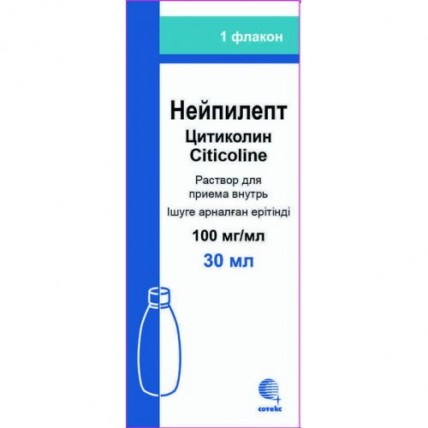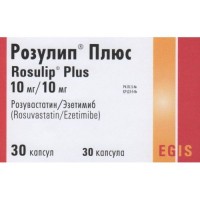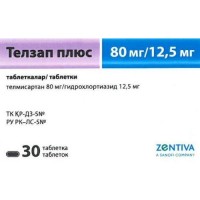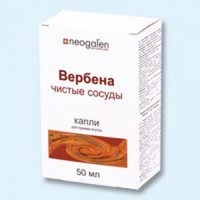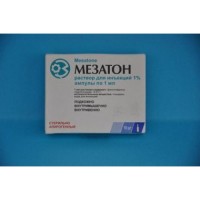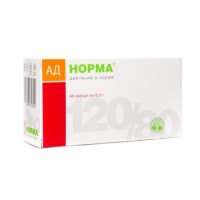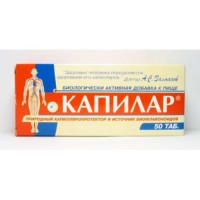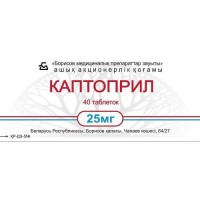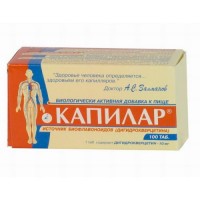Neipilept (Citicoline) 100 mg/ml, 30 ml oral solution
- $44.00
Composition per 1 ml:
Active ingredient - citicoline sodium (in terms of citicoline) 100.0 mg
Excipients: sorbitol, glycerin, sodium citrate, potassium sorbate, methyl parahydroxybenzoate, strawberry flavor, propyl parahydroxybenzoate, sodium saccharinate, citric acid monohydrate, purified water.
Absorption: Citicoline is well absorbed when taken orally.
Absorption after oral administration is almost complete, and bioavailability is almost the same as after intravenous administration.
Metabolism: Citicoline is metabolized in the intestine and liver to form choline and cytidine. After administration, the concentration of choline in the blood plasma increases significantly.
Distribution: Citicoline is extensively distributed in brain structures, with rapid incorporation of choline fractions into structural phospholipids and cytidine fractions into cytidine nucleotides and nucleic acids. Having reached the brain, citicoline is incorporated into cellular, cytoplasmic and mitochondrial membranes, taking part in the construction of the phospholipid fraction.
Excretion: Only 15% of the administered dose of citicoline is excreted from the human body: less than 3% - by the kidneys and about 12% - with exhaled CO2. In the excretion of the drug with urine, there are two phases: the first phase - about 36 hours, in which the rate of excretion decreases rapidly, and the second phase, in which the rate of excretion decreases much more slowly. The same phasing is observed during excretion with CO2, the rate of excretion of exhaled CO2 rapidly decreases after about 15 hours, then it decreases much more slowly.
Citicoline is a natural endogenous compound that is an intermediate metabolite in the synthesis of phosphatidylcholine, one of the main structural components of the cell membrane.
Citicoline has a wide spectrum of action - it helps to restore damaged cell membranes, inhibits the action of phospholipases, prevents excessive formation of free radicals, and also prevents cell death by acting on the mechanisms of apoptosis. In the acute period of stroke, citicoline reduces the amount of brain tissue damage, improves cholinergic transmission. In case of traumatic brain injury, it reduces the duration of post-traumatic coma and the severity of neurological symptoms, in addition, it helps to reduce the duration of the recovery period.
In chronic hypoxia of the brain, citicoline is effective in the treatment of cognitive disorders, such as memory impairment, lack of initiative, difficulties in performing daily activities and self-care. Increases the level of attention and consciousness, and also reduces the manifestation of amnesia.
Citicoline is effective in the treatment of sensory and motor neurological disorders of degenerative and vascular etiology.
- stroke and its consequences
- traumatic brain injury and its consequences
- cognitive, sensory and motor neurological disorders caused by degenerative and vascular disorders of the brain
Neipilept oral solution is administered orally.
Before use, Neipilept can be diluted in a small amount of water (100-120 ml or 1/2 cup). Take with meals or between meals.
Adults: 500–2000 mg (5–20 ml) per day. Dosage and duration of treatment - depending on the severity of the symptoms of the disease.
Elderly patients
When prescribing citicoline to elderly patients, dose adjustment is not required.
Side effects are grouped by frequency of occurrence: very often (> 1/10), often (≥ 1/100 to < 1/10), infrequently (≥ 1/1000 to < 1/100), rarely (≥ 1/10000 to < 1/1000), very rarely (<1/10000), the frequency has not been established.
Very rare (< 1/10000 (including individual cases):
- allergic reactions (rash, itching, anaphylactic shock)
– headache, dizziness, hallucinations, agitation, insomnia, feeling hot, tremor
- shortness of breath
- nausea, vomiting, diarrhea
– edema
- loss of appetite
- numbness in paralyzed limbs
– changes in the activity of liver enzymes
In some cases, citicoline can stimulate the parasympathetic system and also cause a short-term change in blood pressure.
If any of the side effects listed in the package insert get worse, or if you notice any other side effects not listed in the package insert, tell your doctor.
- hypersensitivity to any of the components of the drug
- should not be prescribed to patients with severe vagotonia (high tone of the parasympathetic part of the autonomic nervous system)
- patients with rare hereditary fructose intolerance, malabsorption of glucose-galactose or sucrose-isomaltose due to the presence of sorbitol in the composition
Citicoline enhances the effects of L-dihydroxyphenylalanine.
Do not use concomitantly with medicinal products containing meclofenoxate.
Due to the presence of methyl parahydroxybenzoate and propyl parahydroxybenzoate, allergic reactions (including delayed ones) may develop.
The composition contains sorbitol, so patients with rare hereditary problems of fructose intolerance should not take the drug.
In the cold, a small amount of crystals may form due to temporary partial crystallization of the preservative. Upon further storage under recommended conditions, the crystals will dissolve within a few months. The presence of crystals does not affect the quality of the drug.
Application in pediatrics
Experience in children is limited: therefore, the drug can be prescribed only in cases where the expected therapeutic benefit outweighs any possible risk.
Use during pregnancy and during breastfeeding
There are insufficient data on the use of citicoline in pregnant women. During pregnancy, citicoline is prescribed only in cases where the expected benefit to the mother outweighs the potential risk to the fetus.
When using citicoline during lactation, women should consider stopping breastfeeding, since there are no data on the excretion of citicoline in breast milk.
Features of the influence of the drug on the ability to drive a vehicle or potentially dangerous mechanisms
During the use of the drug, care should be taken when driving and when engaging in other potentially hazardous activities that require an increased concentration of attention and speed of psychomotor reactions.
Given the low toxicity of the drug, cases of overdose are not described, even if therapeutic doses are exceeded.
At a temperature not higher than 25 ° C. Do not freeze.
Keep out of the reach of children.
Shelf life - 2 years.
The period of application after opening the vial is 6 days.
Do not use after the expiration date.
Active ingredient - citicoline sodium (in terms of citicoline) 100.0 mg
Excipients: sorbitol, glycerin, sodium citrate, potassium sorbate, methyl parahydroxybenzoate, strawberry flavor, propyl parahydroxybenzoate, sodium saccharinate, citric acid monohydrate, purified water.
Pharmacological properties
Pharmacokinetics
Absorption: Citicoline is well absorbed when taken orally.
Absorption after oral administration is almost complete, and bioavailability is almost the same as after intravenous administration.
Metabolism: Citicoline is metabolized in the intestine and liver to form choline and cytidine. After administration, the concentration of choline in the blood plasma increases significantly.
Distribution: Citicoline is extensively distributed in brain structures, with rapid incorporation of choline fractions into structural phospholipids and cytidine fractions into cytidine nucleotides and nucleic acids. Having reached the brain, citicoline is incorporated into cellular, cytoplasmic and mitochondrial membranes, taking part in the construction of the phospholipid fraction.
Excretion: Only 15% of the administered dose of citicoline is excreted from the human body: less than 3% - by the kidneys and about 12% - with exhaled CO2. In the excretion of the drug with urine, there are two phases: the first phase - about 36 hours, in which the rate of excretion decreases rapidly, and the second phase, in which the rate of excretion decreases much more slowly. The same phasing is observed during excretion with CO2, the rate of excretion of exhaled CO2 rapidly decreases after about 15 hours, then it decreases much more slowly.
Pharmacodynamics
Citicoline is a natural endogenous compound that is an intermediate metabolite in the synthesis of phosphatidylcholine, one of the main structural components of the cell membrane.
Citicoline has a wide spectrum of action - it helps to restore damaged cell membranes, inhibits the action of phospholipases, prevents excessive formation of free radicals, and also prevents cell death by acting on the mechanisms of apoptosis. In the acute period of stroke, citicoline reduces the amount of brain tissue damage, improves cholinergic transmission. In case of traumatic brain injury, it reduces the duration of post-traumatic coma and the severity of neurological symptoms, in addition, it helps to reduce the duration of the recovery period.
In chronic hypoxia of the brain, citicoline is effective in the treatment of cognitive disorders, such as memory impairment, lack of initiative, difficulties in performing daily activities and self-care. Increases the level of attention and consciousness, and also reduces the manifestation of amnesia.
Citicoline is effective in the treatment of sensory and motor neurological disorders of degenerative and vascular etiology.
Indications for use
- stroke and its consequences
- traumatic brain injury and its consequences
- cognitive, sensory and motor neurological disorders caused by degenerative and vascular disorders of the brain
Dosage and administration
Neipilept oral solution is administered orally.
Before use, Neipilept can be diluted in a small amount of water (100-120 ml or 1/2 cup). Take with meals or between meals.
Recommended dosing regimen
Adults: 500–2000 mg (5–20 ml) per day. Dosage and duration of treatment - depending on the severity of the symptoms of the disease.
Elderly patients
When prescribing citicoline to elderly patients, dose adjustment is not required.
Side effects
Side effects are grouped by frequency of occurrence: very often (> 1/10), often (≥ 1/100 to < 1/10), infrequently (≥ 1/1000 to < 1/100), rarely (≥ 1/10000 to < 1/1000), very rarely (<1/10000), the frequency has not been established.
Very rare (< 1/10000 (including individual cases):
- allergic reactions (rash, itching, anaphylactic shock)
– headache, dizziness, hallucinations, agitation, insomnia, feeling hot, tremor
- shortness of breath
- nausea, vomiting, diarrhea
– edema
- loss of appetite
- numbness in paralyzed limbs
– changes in the activity of liver enzymes
In some cases, citicoline can stimulate the parasympathetic system and also cause a short-term change in blood pressure.
If any of the side effects listed in the package insert get worse, or if you notice any other side effects not listed in the package insert, tell your doctor.
Contraindications
- hypersensitivity to any of the components of the drug
- should not be prescribed to patients with severe vagotonia (high tone of the parasympathetic part of the autonomic nervous system)
- patients with rare hereditary fructose intolerance, malabsorption of glucose-galactose or sucrose-isomaltose due to the presence of sorbitol in the composition
Drug Interactions
Citicoline enhances the effects of L-dihydroxyphenylalanine.
Do not use concomitantly with medicinal products containing meclofenoxate.
Special instructions
Due to the presence of methyl parahydroxybenzoate and propyl parahydroxybenzoate, allergic reactions (including delayed ones) may develop.
The composition contains sorbitol, so patients with rare hereditary problems of fructose intolerance should not take the drug.
In the cold, a small amount of crystals may form due to temporary partial crystallization of the preservative. Upon further storage under recommended conditions, the crystals will dissolve within a few months. The presence of crystals does not affect the quality of the drug.
Application in pediatrics
Experience in children is limited: therefore, the drug can be prescribed only in cases where the expected therapeutic benefit outweighs any possible risk.
Use during pregnancy and during breastfeeding
There are insufficient data on the use of citicoline in pregnant women. During pregnancy, citicoline is prescribed only in cases where the expected benefit to the mother outweighs the potential risk to the fetus.
When using citicoline during lactation, women should consider stopping breastfeeding, since there are no data on the excretion of citicoline in breast milk.
Features of the influence of the drug on the ability to drive a vehicle or potentially dangerous mechanisms
During the use of the drug, care should be taken when driving and when engaging in other potentially hazardous activities that require an increased concentration of attention and speed of psychomotor reactions.
Overdose
Given the low toxicity of the drug, cases of overdose are not described, even if therapeutic doses are exceeded.
Storage conditions
At a temperature not higher than 25 ° C. Do not freeze.
Keep out of the reach of children.
Shelf life - 2 years.
The period of application after opening the vial is 6 days.
Do not use after the expiration date.
